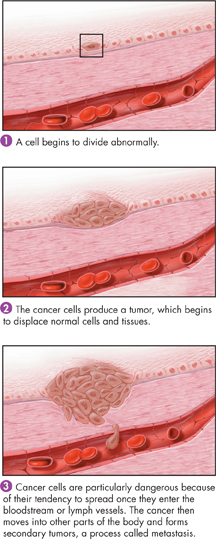Cancer: Uncontrolled Cell Growth
 How do cancer cells differ from other cells?
How do cancer cells differ from other cells?
Why is cell growth regulated so carefully? The principal reason may be that the consequences of uncontrolled cell growth in a multicellular organism are very severe. Cancer, a disorder in which body cells lose the ability to control growth, is one such example.
 Cancer cells do not respond to the signals that regulate the growth of most cells. As a result, the cells divide uncontrollably. Cancer cells form a mass of cells called a tumor. However, not all tumors are cancerous. Some tumors are benign, or noncancerous. A benign tumor does not spread to surrounding healthy tissue or to other parts of the body. Cancerous tumors, such as the one in Figure 10–16, are malignant. Malignant tumors invade and destroy surrounding healthy tissue.
Cancer cells do not respond to the signals that regulate the growth of most cells. As a result, the cells divide uncontrollably. Cancer cells form a mass of cells called a tumor. However, not all tumors are cancerous. Some tumors are benign, or noncancerous. A benign tumor does not spread to surrounding healthy tissue or to other parts of the body. Cancerous tumors, such as the one in Figure 10–16, are malignant. Malignant tumors invade and destroy surrounding healthy tissue.
As the cancer cells spread, they absorb the nutrients needed by other cells, block nerve connections, and prevent the organs they invade from functioning properly. Soon, the delicate balances that exist in the body are disrupted, and life-threatening illness results.
What Causes Cancer? Cancers are caused by defects in the genes that regulate cell growth and division. There are several sources of such defects, including: smoking or chewing tobacco, radiation exposure, other defective genes, and even viral infection. All cancers, however, have one thing in common: The control over the cell cycle has broken down. Some cancer cells will no longer respond to external growth regulators, while others fail to produce the internal regulators that ensure orderly growth.
An astonishing number of cancer cells have a defect in a gene called p53, which normally halts the cell cycle until all chromosomes have been properly replicated. Damaged or defective p53 genes cause cells to lose the information needed to respond to signals that normally control their growth.
 In Your Notebook Use a two-column chart to compare the controls that regulate normal cell growth to the lack of control seen in cancer cells.
In Your Notebook Use a two-column chart to compare the controls that regulate normal cell growth to the lack of control seen in cancer cells.

FIGURE 10–16 Growth of Cancer Cells Normal cells grow and divide in a carefully controlled fashion. Cells that are cancerous lose this control and continue to grow and divide, producing tumors.
dd
Table of Contents
- Formulas and Equations
- Applying Formulas and Equations
- Mean, Median, and Mode
- Estimation
- Using Measurements in Calculations
- Effects of Measurement Errors
- Accuracy
- Precision
- Comparing Accuracy and Precision
- Significant Figures
- Calculating With Significant Figures
- Scientific Notation
- Calculating With Scientific Notation
- Dimensional Analysis
- Applying Dimensional Analysis




